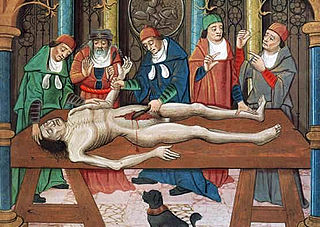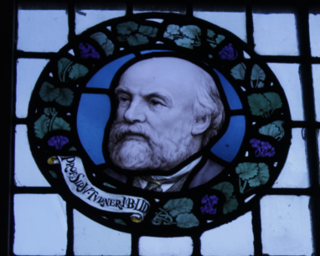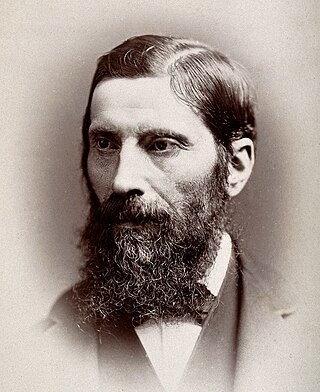
Marsupials are any members of the mammalian infraclass Marsupialia. All extant marsupials are endemic to Australasia, Wallacea and the Americas. A distinctive characteristic common to most of these species is that the young are carried in a pouch. Living marsupials include opossums, Tasmanian devils, kangaroos, koalas, wombats, wallabies, and bandicoots among others, while many extinct species, such as the thylacine, are also known.

The history of anatomy extends from the earliest examinations of sacrificial victims to the sophisticated analyses of the body performed by modern anatomists and scientists. Written descriptions of human organs and parts can be traced back thousands of years to ancient Egyptian papyri, where attention to the body was necessitated by their highly elaborate burial practices.

George Emil Palade was a Romanian-American cell biologist. Described as "the most influential cell biologist ever", in 1974 he was awarded the Nobel Prize in Physiology and Medicine along with Albert Claude and Christian de Duve. The prize was granted for his innovations in electron microscopy and cell fractionation which together laid the foundations of modern molecular cell biology, the most notable discovery being the ribosomes of the endoplasmic reticulum – which he first described in 1955.

Tactile corpuscles or Meissner's corpuscles are a type of mechanoreceptor discovered by anatomist Georg Meissner (1829–1905) and Rudolf Wagner. This corpuscle is a type of nerve ending in the skin that is responsible for sensitivity to pressure. In particular, they have their highest sensitivity when sensing vibrations between 10 and 50 hertz. They are rapidly adaptive receptors. They are most concentrated in thick hairless skin, especially at the finger pads.

In cetology, the study of whales and other cetaceans, a blowhole is the hole at the top of the head through which the animal breathes air. In baleen whales, these are in pairs. It is homologous with the nostril of other mammals, and evolved via gradual movement of the nostrils to the top of the head. The posterior placement of blowholes on cetacean heads is believed to minimize the energy used when breathing at the water's surface. As whales reach the water surface to breathe, they forcefully expel air through the blowhole. The exhalation is released into the comparably lower-pressure, colder atmosphere, and any water vapor condenses. This spray, known as the blow, is often visible from far away as a white splash, which can also be caused by water resting on top of the blowhole.

Palmaris brevis muscle is a thin, quadrilateral muscle, placed beneath the integument of the ulnar side of the hand. It acts to fold the skin of the hypothenar eminence transversally.

The enthesis is the connective tissue between tendon or ligament and bone.

Francis Peyton Rous was an American pathologist at the Rockefeller University known for his works in oncoviruses, blood transfusion and physiology of digestion. A medical graduate from the Johns Hopkins University, he was discouraged to become a practicing physician due to severe tuberculosis. After three years of working as an instructor of pathology at the University of Michigan, he became dedicated researcher at the Rockefeller Institute for Medical Research for the rest of his career.

Sir William Turner was an English anatomist and was the Principal of the University of Edinburgh from 1903 to 1916.

Osteoderms are bony deposits forming scales, plates, or other structures based in the dermis. Osteoderms are found in many groups of extant and extinct reptiles and amphibians, including lizards, crocodilians, frogs, temnospondyls, various groups of dinosaurs, phytosaurs, aetosaurs, placodonts, and hupehsuchians.

In the context of human evolution, human vestigiality involves those traits occurring in humans that have lost all or most of their original function through evolution. Although structures called vestigial often appear functionless, a vestigial structure may retain lesser functions or develop minor new ones. In some cases, structures once identified as vestigial simply had an unrecognized function. Vestigial organs are sometimes called rudimentary organs. Many human characteristics are also vestigial in other primates and related animals.

Edward Percival (Perceval) Wright FRGSI was an Irish ophthalmic surgeon, botanist and zoologist.

Ewald Rudolf Weibel HonFRMS was a Swiss anatomist and physiologist and former director of the Institute of Anatomy at the University of Bern. He was one of the first scientists to describe the endothelial organelles Weibel–Palade bodies, which are named after him and his Romanian-American colleague George Emil Palade. He was known for his work on the anatomy of gas exchange in lungs on multiple spatial scales using stereology.
The median artery is an artery that is occasionally found in humans and other animals.

Charles Joseph Patten (1870–1948) was an Irish anatomist and ornithologist.

Sir George Murray Humphry, FRS was a professor of physiology and anatomy at Cambridge, surgeon, gerontologist and medical writer.
James Thomas Wilson FRS (1861-1945) was a Professor of Anatomy at the University of Cambridge and an elected Fellow of the Royal Society.
Herbert Henry Woollard, FRS was an Australian academic, anatomist and army medical officer.
The Department of Physiology, Development and Neuroscience, (PDN) is a part of the School of Biological Sciences at the University of Cambridge. Research in PDN focuses on three main areas: Cellular and Systems Physiology, Developmental and Reproductive Biology, and Neuroscience and is currently headed by Sarah Bray and William Colledge. The department was formed on 1 January 2006, within the School of Biological Sciences at the University of Cambridge from the merger of the Departments of Anatomy and Physiology. The department hosts the Centre for Trophoblast Research and has links with the Cambridge Centre for Brain Repair, the Cambridge Stem Cell Institute, and the Gurdon Institute.

Gruimorphae is a clade of birds that contains the orders Charadriiformes and Gruiformes identified by molecular analysis. This grouping has had historical support, as various charadriiform families such as the families Pedionomidae and Turnicidae were classified as gruiforms. It may also have support from the fossil record since the discovery of Nahmavis from the Early Eocene of North America.
















